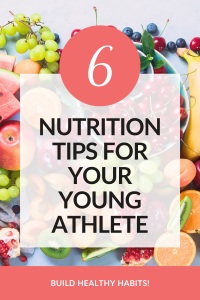
As parents of active kids, especially those in sports, it’s never too early to start teaching them about nutrition. Research shows that children pick up new skills and knowledge—whether it’s a language or understanding food—more easily than teenagers or adults. And in today’s world, where they’re constantly bombarded by fast food ads and sugary treats, it’s important to equip them with the tools to make smart choices.
For many of us, growing up meant being surrounded by talk of diets like South Beach, Weight Watchers, or Whole30, and often, the conversation wasn’t exactly body-positive. As a mom, I promised myself I’d break that cycle for my family. Instead of focusing on restriction or guilt, I want to teach my kids the true value of food—how to enjoy it and understand its benefits without fear or shame.
Kids are like sponges, and what they learn about food now will stick with them into adulthood. As parents, we have a unique opportunity to shape their understanding of nutrition in a positive way. While I’m not a registered dietitian, I have over a decade of experience as a certified NASM Fitness Nutrition Specialist and a Level 1 Nutrition Coach through Precision Nutrition. My focus is on how food fuels the body, especially for exercise. Here’s how I approach teaching my young athlete about balanced eating.
You control what food enters the house, what meals are served, and when it’s time to eat. But it’s important to make eating an enjoyable experience, not a chore. While you’re responsible for providing nutritious options, your child should have a say in what they eat from those choices. Empowering them to help choose pre-game snacks or letting them tell you when they’re full gives them a sense of control and responsibility over their eating habits.
Your child is always watching! If they see you making healthy food choices, sitting down to enjoy meals, and trying new things, they’re likely to mimic those behaviors. Avoid multitasking during meals and make an effort to enjoy the food you’re eating. Your positive example can make a big impact on how they approach their own nutrition.
One of the best ways to teach your young athlete about healthy eating is by relating food to something they understand: their sport. Talk about how chicken, for instance, is full of protein that helps build strong muscles, or how carrots can improve their vision—just like their favorite athletes. When kids see the connection between what they eat and how it helps them perform better on the field/ice, they’re more likely to embrace healthy choices.
Kids love having a say in what they eat! Whether it’s letting them pick out a new fruit or vegetable at the grocery store or choosing a meal for the week, giving them some control makes them more excited to try new foods. When kids feel involved in the decision-making process, they’re more open to eating healthier.
Who doesn’t love a good taco bar or build-your-own pizza night? Letting kids customize their meals with pre-selected healthy options is a great way to sneak in balanced nutrition without making it feel like a chore. They get the freedom to choose what they like, and you ensure that the options are nutritious. It’s a win-win!
One of the hardest habits to break is labeling foods as “good” or “bad.” It’s important to shift away from this mindset and help your child understand that all foods can have a place in a balanced diet. Yes, cookies and candy can be enjoyed occasionally without guilt, and it’s crucial to acknowledge that. Instead of banning certain foods, teach your child that it’s all about balance. Too many sweets may upset their stomach, but enjoying them in moderation is perfectly okay.
The 80/20 rule is a simple and effective guideline for helping young athletes balance their nutrition. It encourages eating healthy, nutrient-dense foods 80% of the time and allowing some room for fun treats the other 20%. This approach helps take the pressure off both you and your child while teaching them how to enjoy a variety of foods without feeling restricted.
As parents, our goal should be to empower our kids with the knowledge they need to make their own decisions when it comes to nutrition. These six principles are just a starting point, not hard-and-fast rules. By teaching your child about balanced eating early on, you’ll help set them up for a lifetime of healthy habits—both on and off the field/ice.

Know other families struggling to help feed their young athlete? Share with your sport bestie.
We’re all in this together!